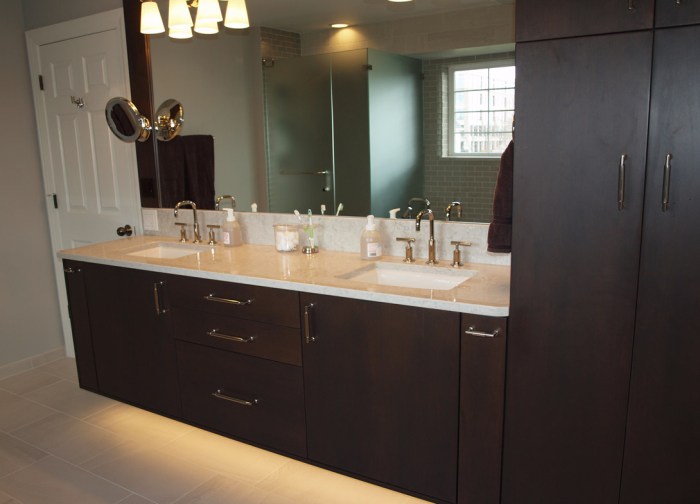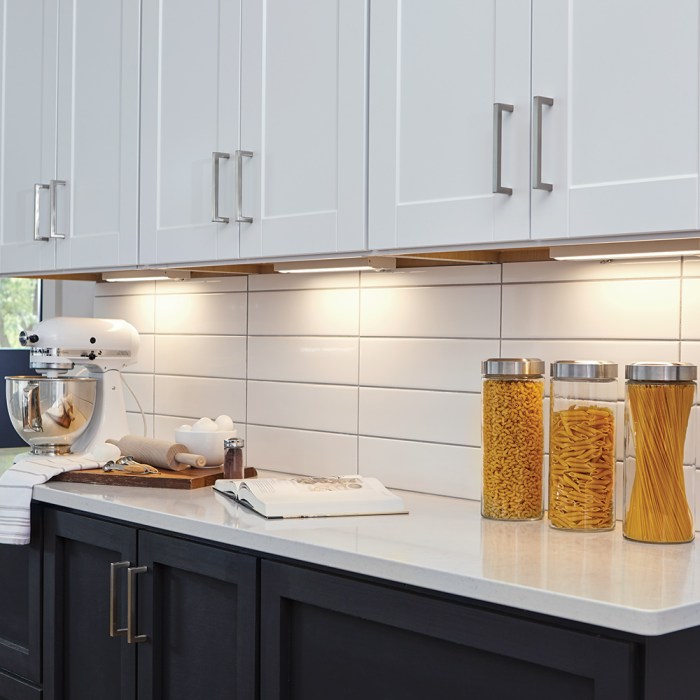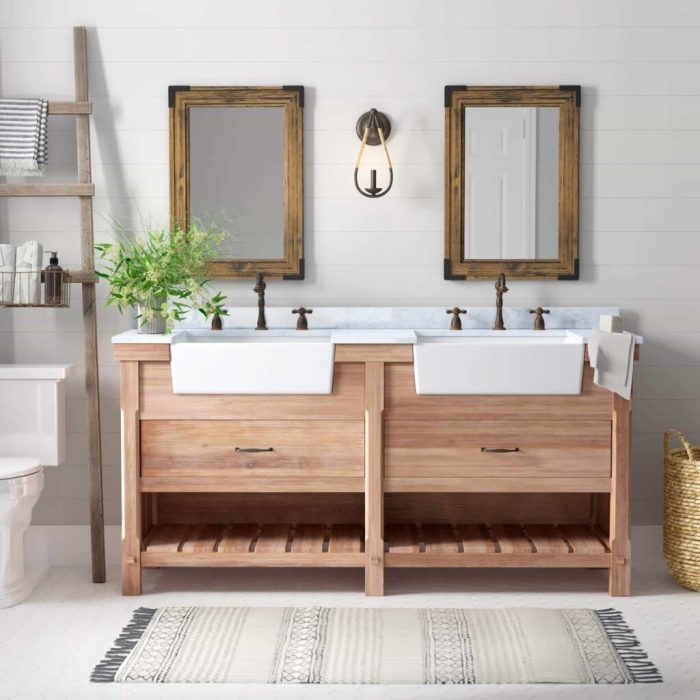Under-cabinet lighting is a transformative element that can elevate the aesthetics and functionality of any bathroom. By illuminating the space beneath your vanity, you not only enhance the visibility for tasks like shaving and applying makeup but also create a warm and inviting ambiance.
In this comprehensive guide, we’ll explore the different types of under-cabinet lighting available, discuss the factors to consider during installation, and provide tips for choosing the perfect lighting solution for your bathroom vanity.
Vanity Lighting Design
Under-cabinet lighting is an essential element of any bathroom vanity. It provides task lighting for grooming and makeup application, and it can also enhance the overall aesthetics of the bathroom.
When choosing under-cabinet lighting, it is important to consider the style of your vanity. For a traditional vanity, a simple strip of LED lighting can be a good choice. For a more modern vanity, a more decorative fixture, such as a pendant light or a sconce, can be a better option.
Choosing the Right Under-Cabinet Lighting
Here are a few tips for choosing the right under-cabinet lighting for your bathroom vanity:
- Consider the size of your vanity. A small vanity will need a smaller light fixture than a large vanity.
- Consider the style of your vanity. A traditional vanity will need a different light fixture than a modern vanity.
- Consider the amount of light you need. If you need a lot of light for grooming and makeup application, you will need a brighter light fixture.
- Consider the color temperature of the light. A warm light will create a more inviting atmosphere, while a cool light will be more energizing.
Types of Under-Cabinet Lighting
Under-cabinet lighting for bathroom vanities comes in various types, each with unique advantages and disadvantages. Choosing the right type depends on factors such as the desired brightness, beam angle, color temperature, and energy efficiency.
Linear LED Strips
- Advantages: Even light distribution, customizable length, low profile, energy-efficient
- Disadvantages: Can create visible hot spots, may require professional installation
- Uses: Providing general illumination, accentuating mirrors or artwork
Puck Lights
- Advantages: Compact, easy to install, adjustable beam angle
- Disadvantages: May create shadows, less energy-efficient than LED strips
- Uses: Task lighting for shaving or applying makeup, highlighting specific areas
Bar Lights
- Advantages: Wide beam angle, easy to install, available in various lengths
- Disadvantages: Can be bulky, may not provide sufficient brightness for large vanities
- Uses: General illumination, providing ambient light in small bathrooms
Installation Considerations
When installing under-cabinet lighting, several factors must be taken into account to ensure a successful outcome. These include the type of lighting fixture, the location of the fixture, and the electrical wiring. The installation method will also vary depending on the type of fixture and the location.
Planning the Installation
Before beginning the installation, it is important to plan the layout of the lighting fixtures. The fixtures should be placed so that they provide even illumination across the countertop. The distance between the fixtures will depend on the type of fixture and the desired level of illumination.
Energy Efficiency
Energy efficiency is a crucial consideration when selecting under-cabinet lighting for bathroom vanities. By opting for energy-efficient options, you can reduce your energy consumption and save money on utility bills.There are several energy-efficient lighting options available, including:
LED Lighting
LED (light-emitting diode) lights are highly energy-efficient, consuming up to 80% less energy than traditional incandescent bulbs. They also have a longer lifespan, lasting up to 50,000 hours, which reduces the need for frequent replacements.
Compact Fluorescent Lamps (CFLs)
CFLs are another energy-efficient option that uses up to 75% less energy than incandescent bulbs. They have a shorter lifespan than LEDs, but still last longer than incandescent bulbs.
Tips for Reducing Energy Consumption
In addition to choosing energy-efficient bulbs, there are other ways to reduce energy consumption with under-cabinet lighting:
- Use a dimmer switch to adjust the brightness of the lights, which can save energy when you don’t need full brightness.
- Install a motion sensor to turn the lights on only when someone is present, which can prevent unnecessary energy waste.
- Consider using natural light as much as possible by placing your vanity near a window.
Cost Considerations
When budgeting for under-cabinet lighting, consider the following cost factors:
The type of lighting you choose, the length of the lighting fixture, and the number of fixtures needed will impact the overall cost. Additional features, such as dimmers or motion sensors, can also increase the price.
Factors Affecting Cost
- Type of lighting: LED lights are generally more expensive than fluorescent or incandescent bulbs, but they are also more energy-efficient and last longer.
- Length of the fixture: The longer the fixture, the more it will cost.
- Number of fixtures: The more fixtures you need, the higher the cost will be.
- Additional features: Dimmers and motion sensors can add to the cost of the lighting fixture.
Tips for Finding Affordable Options
- Shop around: Compare prices from different retailers before you buy.
- Consider buying a kit: Kits that include everything you need to install the lighting can be more affordable than buying the components separately.
- Look for sales: Many retailers offer sales on under-cabinet lighting throughout the year.
- Consider DIY: If you’re handy, you can save money by installing the lighting yourself.
Trends in Under-Cabinet Lighting
Under-cabinet lighting has become increasingly popular in recent years, as it provides a stylish and functional way to illuminate your bathroom vanity. Here are some of the latest trends in under-cabinet lighting:
One of the biggest trends in under-cabinet lighting is the use of LED lights. LED lights are energy-efficient, long-lasting, and produce a bright, even light. They are also available in a variety of colors, so you can choose the perfect light to match your bathroom décor.
Another trend in under-cabinet lighting is the use of motion sensors. Motion sensors turn on the lights automatically when you enter the bathroom, and turn them off when you leave. This is a great way to save energy and make your bathroom more convenient.
Finally, under-cabinet lighting is becoming increasingly customizable. You can now choose from a variety of different styles, finishes, and colors to create a look that is unique to your bathroom.
Incorporating Trends into Your Bathroom
Here are a few tips for incorporating the latest trends in under-cabinet lighting into your own bathroom:
- Use LED lights to save energy and get a bright, even light.
- Install motion sensors to make your bathroom more convenient and energy-efficient.
- Choose a style, finish, and color that complements your bathroom décor.
DIY vs. Professional Installation
DIY Installation
Pros:
Cost savings
DIY installation can save you significant money compared to hiring a professional.
Flexibility
You have complete control over the installation process, allowing you to customize the lighting to your specific needs.
Personal satisfaction
Completing the installation yourself can provide a sense of accomplishment and satisfaction. Cons:
Technical challenges
Under-cabinet lighting installation involves electrical work, which can be complex and dangerous if not done correctly.
Time-consuming
DIY installation can take several hours or even days, depending on the complexity of the project.
Warranty issues
Some lighting fixtures may have warranties that are voided if they are not installed by a professional.
Professional Installation
Pros:
Safety and expertise
Professionals are trained and experienced in electrical work, ensuring a safe and code-compliant installation.
Time-saving
Professionals can complete the installation quickly and efficiently, saving you time and hassle.
Warranty protection
Many professional installers offer warranties on their work, providing peace of mind. Cons:
Cost
Professional installation typically costs more than DIY installation.
Limited availability
Finding a qualified electrician may be challenging, especially during peak seasons.
Inflexibility
Professionals may not be as willing to accommodate specific customization requests.
Making an Informed Decision
The best option for you depends on your budget, DIY skills, and the complexity of the project. If you are comfortable with electrical work and have the time, DIY installation can be a cost-effective solution. However, if you prioritize safety, convenience, and warranty protection, professional installation is the better choice.
Closure
Whether you’re looking to upgrade your existing bathroom or designing a new one, under-cabinet lighting is a versatile and stylish addition that can transform your space. By considering the various options, installation considerations, and latest trends, you can create a bathroom that is both beautiful and functional.



